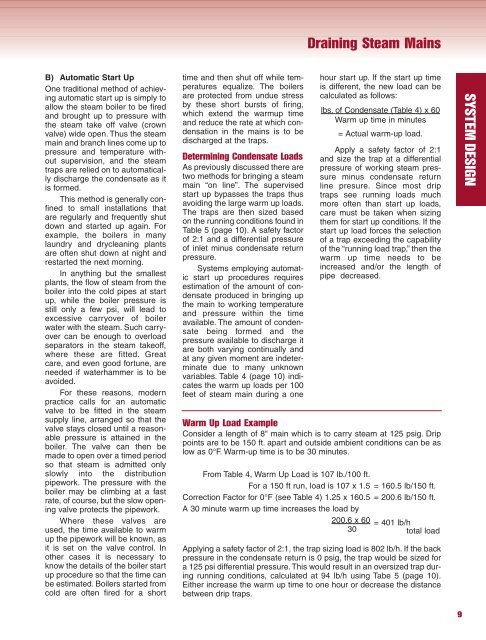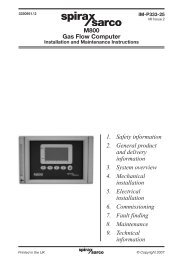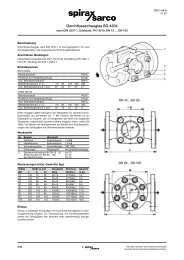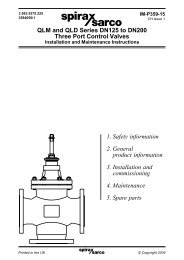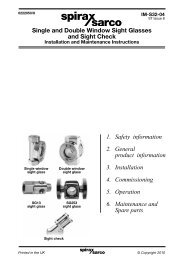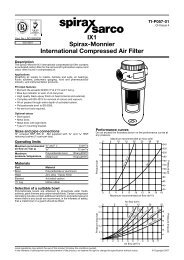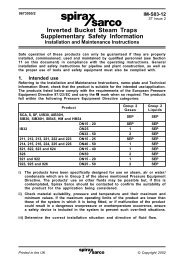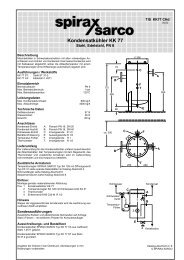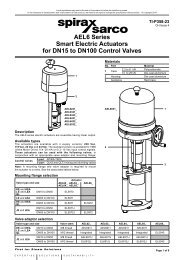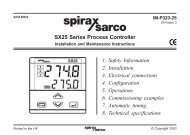2000 Hook-up Book - Spirax Sarco
2000 Hook-up Book - Spirax Sarco
2000 Hook-up Book - Spirax Sarco
Create successful ePaper yourself
Turn your PDF publications into a flip-book with our unique Google optimized e-Paper software.
B) Automatic Start Up<br />
One traditional method of achieving<br />
automatic start <strong>up</strong> is simply to<br />
allow the steam boiler to be fired<br />
and brought <strong>up</strong> to pressure with<br />
the steam take off valve (crown<br />
valve) wide open. Thus the steam<br />
main and branch lines come <strong>up</strong> to<br />
pressure and temperature without<br />
s<strong>up</strong>ervision, and the steam<br />
traps are relied on to automatically<br />
discharge the condensate as it<br />
is formed.<br />
This method is generally confined<br />
to small installations that<br />
are regularly and frequently shut<br />
down and started <strong>up</strong> again. For<br />
example, the boilers in many<br />
laundry and drycleaning plants<br />
are often shut down at night and<br />
restarted the next morning.<br />
In anything but the smallest<br />
plants, the flow of steam from the<br />
boiler into the cold pipes at start<br />
<strong>up</strong>, while the boiler pressure is<br />
still only a few psi, will lead to<br />
excessive carryover of boiler<br />
water with the steam. Such carryover<br />
can be enough to overload<br />
separators in the steam takeoff,<br />
where these are fitted. Great<br />
care, and even good fortune, are<br />
needed if waterhammer is to be<br />
avoided.<br />
For these reasons, modern<br />
practice calls for an automatic<br />
valve to be fitted in the steam<br />
s<strong>up</strong>ply line, arranged so that the<br />
valve stays closed until a reasonable<br />
pressure is attained in the<br />
boiler. The valve can then be<br />
made to open over a timed period<br />
so that steam is admitted only<br />
slowly into the distribution<br />
pipework. The pressure with the<br />
boiler may be climbing at a fast<br />
rate, of course, but the slow opening<br />
valve protects the pipework.<br />
Where these valves are<br />
used, the time available to warm<br />
<strong>up</strong> the pipework will be known, as<br />
it is set on the valve control. In<br />
other cases it is necessary to<br />
know the details of the boiler start<br />
<strong>up</strong> procedure so that the time can<br />
be estimated. Boilers started from<br />
cold are often fired for a short<br />
time and then shut off while temperatures<br />
equalize. The boilers<br />
are protected from undue stress<br />
by these short bursts of firing,<br />
which extend the warm<strong>up</strong> time<br />
and reduce the rate at which condensation<br />
in the mains is to be<br />
discharged at the traps.<br />
Determining Condensate Loads<br />
As previously discussed there are<br />
two methods for bringing a steam<br />
main “on line”. The s<strong>up</strong>ervised<br />
start <strong>up</strong> bypasses the traps thus<br />
avoiding the large warm <strong>up</strong> loads.<br />
The traps are then sized based<br />
on the running conditions found in<br />
Table 5 (page 10). A safety factor<br />
of 2:1 and a differential pressure<br />
of inlet minus condensate return<br />
pressure.<br />
Systems employing automatic<br />
start <strong>up</strong> procedures requires<br />
estimation of the amount of condensate<br />
produced in bringing <strong>up</strong><br />
the main to working temperature<br />
and pressure within the time<br />
available. The amount of condensate<br />
being formed and the<br />
pressure available to discharge it<br />
are both varying continually and<br />
at any given moment are indeterminate<br />
due to many unknown<br />
variables. Table 4 (page 10) indicates<br />
the warm <strong>up</strong> loads per 100<br />
feet of steam main during a one<br />
Draining Steam Mains<br />
hour start <strong>up</strong>. If the start <strong>up</strong> time<br />
is different, the new load can be<br />
calculated as follows:<br />
lbs. of Condensate (Table 4) x 60<br />
Warm <strong>up</strong> time in minutes<br />
= Actual warm-<strong>up</strong> load.<br />
Apply a safety factor of 2:1<br />
and size the trap at a differential<br />
pressure of working steam pressure<br />
minus condensate return<br />
line presure. Since most drip<br />
traps see running loads much<br />
more often than start <strong>up</strong> loads,<br />
care must be taken when sizing<br />
them for start <strong>up</strong> conditions. If the<br />
start <strong>up</strong> load forces the selection<br />
of a trap exceeding the capability<br />
of the “running load trap,” then the<br />
warm <strong>up</strong> time needs to be<br />
increased and/or the length of<br />
pipe decreased.<br />
Warm Up Load Example<br />
Consider a length of 8" main which is to carry steam at 125 psig. Drip<br />
points are to be 150 ft. apart and outside ambient conditions can be as<br />
low as 0°F. Warm-<strong>up</strong> time is to be 30 minutes.<br />
From Table 4, Warm Up Load is 107 lb./100 ft.<br />
For a 150 ft run, load is 107 x 1.5 = 160.5 lb/150 ft.<br />
Correction Factor for 0°F (see Table 4) 1.25 x 160.5 = 200.6 lb/150 ft.<br />
A 30 minute warm <strong>up</strong> time increases the load by<br />
200.6 x 60 = 401 lb/h<br />
30<br />
total load<br />
Applying a safety factor of 2:1, the trap sizing load is 802 lb/h. If the back<br />
pressure in the condensate return is 0 psig, the trap would be sized for<br />
a 125 psi differential pressure. This would result in an oversized trap during<br />
running conditions, calculated at 94 lb/h using Tabe 5 (page 10).<br />
Either increase the warm <strong>up</strong> time to one hour or decrease the distance<br />
between drip traps.<br />
9<br />
SYSTEM DESIGN


